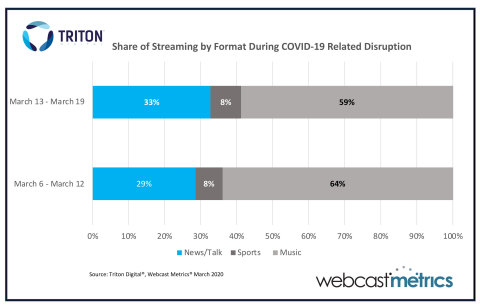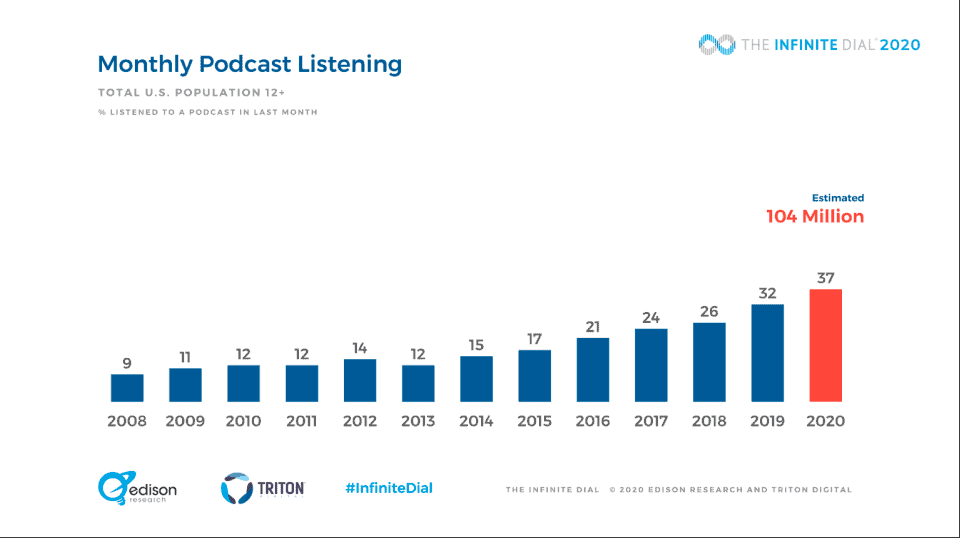Edison Research and Triton Digital released their podcast statistics and digital media consumption in March 2020. This presentation was slightly different as we globally navigate the Covid-19 landscape and what that means for content creators.
In this episode of Audience, we’re recapping the most relevant consumption data for podcasters and how to take advantage of what’s to come. The podcasting industry is still in its infancy with plenty of room to grow. For those currently producing a show or deciding when to get started, use these podcast statistics to position yourself for success.
If you’re starting a new podcast or running into unforeseen issues with remote production setups, drop your questions in the comments here or tweet us @CastosHQ. We’ll answer all of your questions on the next episode of Audience.
Podcast Statistics From The Infinite Dial March 2020 Survey
Edison Research and Triton Digital surveyed 1,500 randomly sampled people from the United States. The questions focused on a person’s digital media consumption habits and awareness of media brands. The following results are an opportunity for podcasters to take stock of their show and strategize how to increase their listenership.
But before jumping into the most recent statistics, we’ll start with the elephant in the room. Amid Covid-19, our routines and habits have changed dramatically. In the short term this means downloads may decrease across multiple podcast genres. While news and talk show are being prioritized now, these audio trends will predict our consumption behaviors when we’re back to the new normal.
The following data highlights the digital media and audio habits of Americans as of March 2020. Separated into smart speaker, social media, and online audio categories, these trends are shaping our current landscape. All reference data can be found inside The Infinite Dial March 2020 presentation.
Smart speakers
- 27% of Americans own a smart speaker or 76 million people. This is a 4% increase compared to 2019.
- Between Amazon Alexa, Google Home, and Apple HomePod, Alexa is the most popular smart speaker. With 21% of smart speaker owners use Amazon Alexa.
- 55% of the people who own smart speakers own 2+ devices.
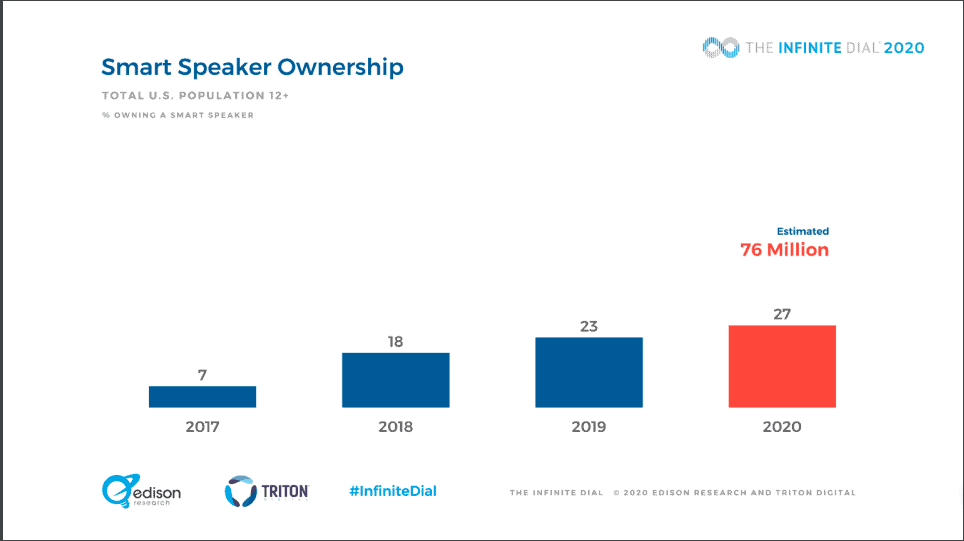
Alexa is king of smart speaker world. Submit your podcast to TuneIn so listeners can access your show on their smart speaker. Then use AnyPod to customize the Alexa skill users can use to launch your show.
Social media & WhatsApp
- Facebook usage has remained relatively constant since 2018. But it is still the most popular platform with 54% of people using it most often.
- For users 34 and under, Instagram is the second most often used social media app. For those older than 35, Facebook continues to be their platform of choice.
- TikTok entered the market with 25% of users 34 and under using the platform.
- 29% of people under 34 use WhatsApp to stay connected, compared to 23% last year.
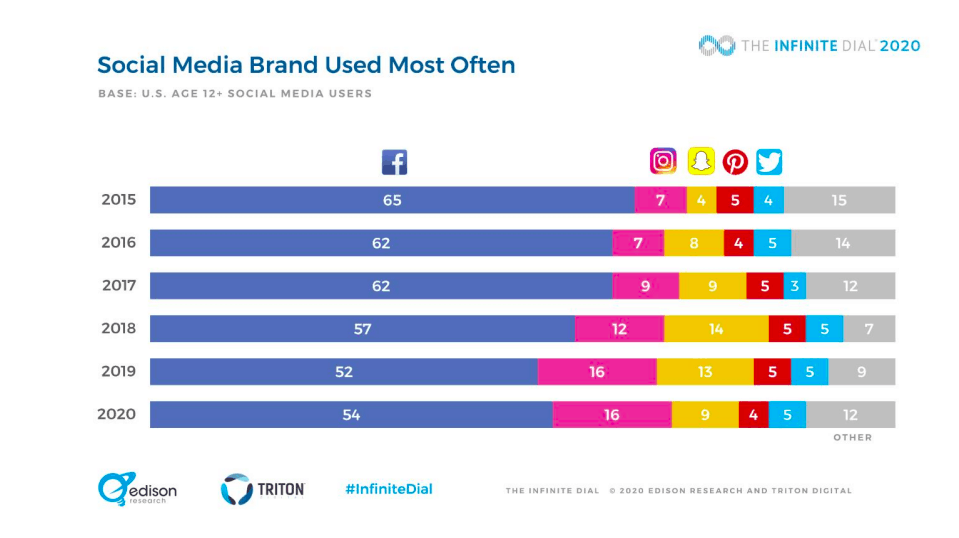
Podcasting & online audio
- Users 35 and older had the biggest increase in online audio consumption. Their preferred platforms are Pandora and Spotify.
- 155 million people, or 55% of the population, have listened to a podcast. But 75% of Americans are aware of the medium.
- 9% more users who are 35 and older listen to podcasts monthly.
- 7% more women are monthly podcast listeners, compared to a 3% increase in male listeners.
- On average, users spent 6:39 hours per week listening to podcasts. This figure has remained flat since 2018.
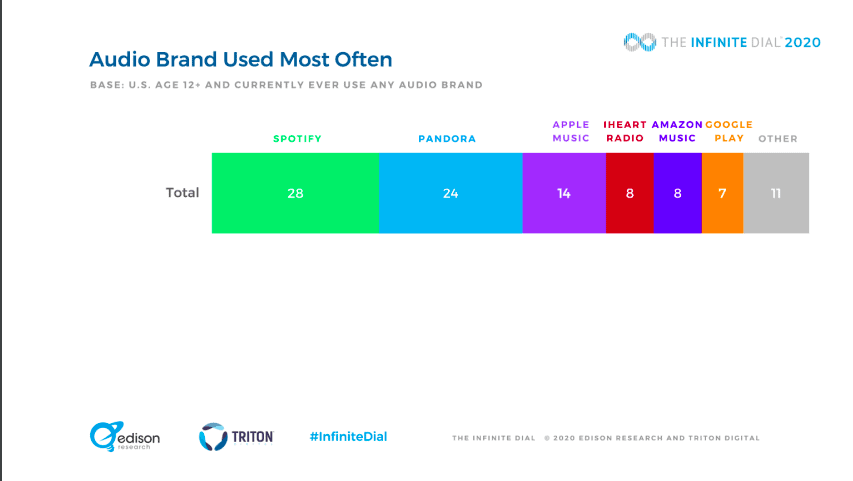
Spotify’s prominence for online audio consumption can’t be overstated. Make sure your show is available on their platform by following these podcast submission instructions.
And don’t forget about Pandora. They started streaming podcasts in November 2019. Here’s a step-by-step guide on how to submit a podcast to their platform too.
Industry Predictions Based On Latest Podcast Trends
It’s always a good idea to use data to inform strategy pivots or before launching a new show. Based on the latest Infinite Dial findings, our team put together a few predictions and opportunities around where the biggest advantages are.
Podcasts tailored to environment-specific themes
Over half of smart speaker owners now have more than two devices in their homes. Users consume different content across each device depending on which room its located and what time of day it is.
With these new listening patterns, there’s an opportunity to create podcasts specific to an environment. For example, as people head to bed they’ll ask Alexa to turn on their favorite meditation podcast. But when they’re prepping dinner, they’ll ask the smart speaker in the kitchen to play Bon Appétit’s Foodcast.
We encourage podcasters to think about how and when people move throughout their homes. How can your podcast complement each environment and a listener’s content needs.
Instagram and TikTok is where listeners under 30 spend the most time
Though Facebook usage has flatlined for this demographic, Instagram and TikTok are having a moment. For both platforms, video content is consumed more than other post types.
If your podcast’s ideal listener falls into this age group, start prioritizing these platforms within a promotional strategy. Test out audiograms or video podcasting to put your show in front of your target demographic.
Castos is integrated with Headliner, one of the most popular audiogram makers. Automatically create custom video assets directly from your Castos dashboard to make your podcast standout.
WhatsApp can create more intimate two-way connections
Right now, Facebook groups dominate the space of allowing hosts to directly engage with their listeners. But people under 30 are now adopting WhatsApp as a new platform for group chats.
WhatsApp is a global communication app that’s more intimate and high touch than other mediums. At a time when many are craving personal connections, podcasters should consider WhatsApp groups as a new way to open up direct lines of communication with their listeners.
Another bonus, WhatsApp is a mobile-first app which is likely where your audience is already consuming your podcast. No need to switch between multiple devices and users can chime into the conversation while they listen along to the latest episode.
Woman-centric podcasts are poised for success
With the increase in female listenership in 2020, there’s an opportunity to connect with this traditionally under served demographic. Female hosted shows and podcasts that focus on their needs, problems, and content preferences have an opportunity to do well.
The onus is on us to increase the market share
With audiences spending just over six hours a week consuming podcasts, there is a finite number of minutes to go around. Our previous Audience guest, Jack Rhysider, highlighted this trend when saying people only tune into great podcasts. Good shows won’t make it into a listener’s rotation because they’re prioritizing great content.
We recognize the difficulty in increasing the total time people spend with podcasts per week. With other audio and video content to compete with and only 24 hours in the day, this is the harder statistic to increase. What’s more realistic is increasing the total number of podcast listeners in general.
To do this, the onus is on us. The podcasters, hosting platforms, listening apps, and audience members. Together let’s educate the uninitiated and promote the benefits of the medium to as many people as possible. As total listenership increases, so will the total number of listeners for your show and ours.

